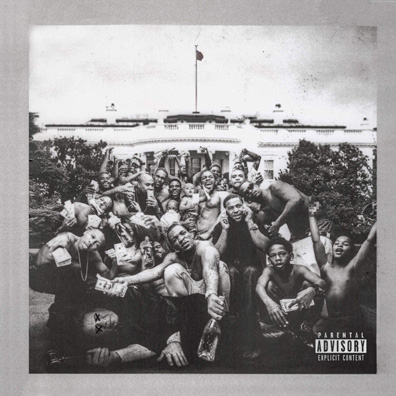
Kendrick Lamar
To Pimp a Butterfly
TDE/Aftermath/Interscope
Mar 25, 2015
Web Exclusive
![]()
Kendrick Lamar is not reluctant when it comes to being the voice of a generation. He may sound conflicted about his actions on record—insecure, remorseful, angry, pensive, probing—but he doesn’t shirk the responsibility that comes with the power he has over his listeners. That’s an important idea to understand when unpacking the dense opus that is To Pimp a Butterfly, Lamar’s insanely anticipated third album that unexpectedly dropped in the evening the Sunday before last. He’s at his most engaged and interested when he’s making music that digs deep into his personal headspace, sins and good deeds alike, as a way to connect with listeners outside of the mainstream rap feedback loop of—what he perceives to be—hood dreams, drug dealing bravado, and misogyny.
His last record, the now canonical good kid, m.A.A.d. city, was a poignant reflection on his past growing up in Compton, as he attempted to navigate the menace, pleasure, and temptation lurking around each and every corner. To Pimp a Butterfly is Lamar’s attempt to comprehend and articulate what he’s gone through since he left Compton; an unflinchingly personal record that doubles as a ruminative poem on the black experience in America today.
Wrestling with the present is a whole lot more complicated than sifting through the past, and as a result, To Pimp a Butterfly is not an easy album to step into, especially for anyone expecting a conventional hip-hop record. Lamar’s taste in beats has always hewed closely to a modernized version of Dr. Dre’s early ‘90s G-Funk, all spacey squeals of synths, watery bass lines, and grooves galore. But now, he’s augmented his regular list of producers, specifically TDE’s in-house go-to Sounwave, by tapping collaborators like future-jazz savants Flying Lotus, Thundercat, as well as neo-soul singers Bilal and Anna Wise, and legends like George Clinton, Ronald Isley, and Snoop Dogg, embracing defiantly shapeless sketches of funk, soul, and acid jazz.
The song progression and whacked out beats allow Lamar to unfurl every lyrical weapon in his arsenal, and he takes on a dizzying array of cadences, vocal dynamics, and thematic content to put together an intimidating document that stands a part from any hip-hop record released in the last decade. The message of To Pimp a Butterfly is evident in the opening couplet of the Flying Lotus-produced opener “Wesley’s Theory” that attacks the way black artists are pimped out in the entertainment industry and the Parliament/James Brown-inspired “King Kunta,” in which Kendrick uses Kunta Kinte as a metaphor for the way he’s both celebrated and oppressed as a wealthy black man in America.
As the record progresses, through the spacey-funk, jazz-freak out soup of “Institutionalized,” “These Walls,” and “u,” Lamar continually uses his personal turmoil to paint larger pictures of the black struggle, avoiding easy verses and catchy hooks, instead opting for an almost spoken-word looseness that routinely circumvents the rhythms of rapping dictated by the beats at hand. He snaps back into focus with the Pharrell assisted “Alright,” attempting to reconcile the soul searching of the previous tracks by facing his post-depression malaise through hard spitting bar after bar, but even his effort to stay lucid in the moment proves to be confounding in the face of a society that continually and systematically seeks to exploit his culture and limit his influence.
And the reality is, that’s only half the record, with every preceding song worthy of a close reading to understand all the things that Lamar has laid out for his listeners. The second half doesn’t let down what Lamar set up in the first, especially the fire breathing evisceration “The Blacker the Berry,” and the fragmented soul of the epic closing track “Mortal Man,” but frankly, the record needs to be understood as one piece, each track inextricable from another. To Pimp a Butterfly is Lamar firmly embracing his place at the pulpit, looking into himself and out into the world simultaneously, and using his influence to paint a powerful, enduring picture of the black American experience. He’s ringing the bell, letting us all know that the chickens are coming home to roost. (www.kendricklamar.com)
Author rating: 9/10
Average reader rating: 10/10
Current Issue

Issue #72
Apr 19, 2024 Issue #72 - The ‘90s Issue with The Cardigans and Thurston Moore
Most Recent
- The Obsessed, Howling Giant @ Brooklyn Meadows, NYC, April 12, 2024 (Review) —
- Premiere: Slow Joy Releases New Single and Video for “King Cowboy” (News) —
- Premiere: Mackenzie Shrieve Shares New Single “Didn’t I Tell Ya” Feat. Jane Bruce (News) —
- Hovvdy (Review) —
- Descendents, Circle Jerks @ Brooklyn Paramount, NYC, April 13, 2024 (Review) —

Comments
Submit your comment
There are no comments for this entry yet.